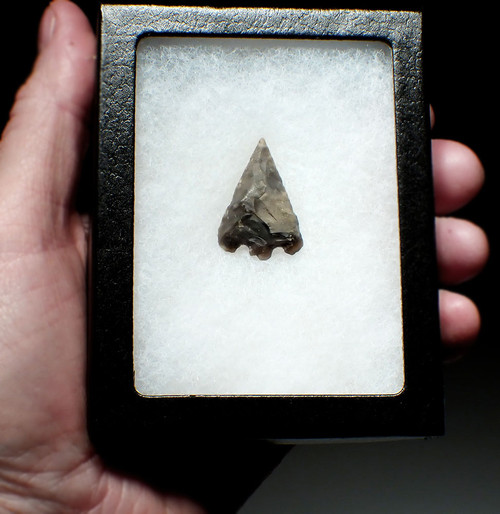Product Description
SEE MORE EUROPEAN BRONZE AGE ARTIFACTS
Neolithic and Early Bronze Age arrowheads from Britain and Ireland of this level of workmanship and rarity, are so scarce, they are most often only seen in museums. For reference, the 7th Edition Overstreet Indian Arrowhead Price Guide has some shown on page 1089. Despite this being a publication dated 25 years ago, some points listed of equal workmanship and rarity shows prices in the thousands of dollars.
The Early Bronze Age Bell Beaker Culture in Ireland (circa 2500-1700 BC) was a period of change including the introduction of ‘Beaker’ style pottery and the advent of metalworking. Barbed and tanged flint arrowheads show the manufacture and use of flint tools continued to be an important part of people’s lives despite the advent of metallurgy. Archaeological evidence suggests they were used as projectiles in both hunting activities and as weapons in warfare. Flint arrowheads have often been discovered in grave goods from archaeological sites, suggesting they performed significant roles in both, life and death in the Early Bronze Age.
One of the rarest flint artifacts of the Early Bronze Age Bell Beaker Culture in Ireland, are the flint barbed and tanged arrowheads. Their diminutive size and fragile nature make them difficult to find, even in fragmented condition. Complete, undamaged examples of exceptional workmanship are ESPECIALLY RARE, and were considered HIGHLY PRIZED prestige objects in ancient life, as well as in death. Excavations of Early Bronze Age graves, have yielded finely made examples, considered to be objects of prestige and honor, to join the deceased in the afterlife. Bell Beaker Early Bronze Age flint arrowheads are rarely, if ever seen on the private market, making this an extraordinarily rare opportunity for a museum or highly advanced collector to add an important addition to their collection.
Ancient or prehistoric artifacts of ANY period, having been found in Ireland, are RARELY seen available for sale.
Made with exquisite symmetry and highly detailed secondary flaking, the impeccable preservation on this specimen shows us every original detail. This stunning PRESTIGE bifacial tanged and barbed flint Bell Beaker Culture arrowhead represents the zenith of skill of an Early Bronze Age master flintknapper. Without question, it shows workmanship that went way beyond what was ordinarily needed for simple hunting or warfare tasks, indicating it was a prestige object. The tip is still needle-sharp as it was originally made over 4000 years ago! The delicate barbs are amazingly unbroken. The translucent honey-colored flint possesses a rich patina that highlights the masterful flaking. It was found in County Galway, Ireland, some time during the late 19th century to early 20th century. From a very old private British collection.
Original ground minerals and sediment are still intact in hinge fractures - an indicator ONLY seen in AUTHENTIC specimens. Genuine tools from the Bell Beaker Culture represent an excellent opportunity to acquire a artifacts from some of the Europe's earliest metal societies where stone was still being used as the introduction of copper and bronze began to dominate tool technology.
HISTORY
The Bell Beaker culture, also known as the Bell Beaker complex or Bell Beaker phenomenon, is an archaeological culture named after the inverted-bell beaker drinking vessel used at the very beginning of the European Bronze Age, arising from around 2800 BC.
Beakers arrived in Ireland c. 2500 BC and fell out of use c. 1700 BC. The beaker pottery of Ireland was rarely used as a grave good, but is often found in domestic assemblages from the period. This stands in contrast to the rest of Europe where it is frequently found in both roles. The inhabitants of Ireland used food vessels as a grave good instead. The large, communal passage tombs of the Irish Neolithic were no longer being constructed during the Early Bronze Age. The preferred method of burial seems to have been single graves and cists in the east, or in small wedge tombs in the west. Cremation was also common.
Beakers are found in large numbers in Ireland, and the technical innovation of ring-built pottery indicates that the makers were also present. Flint arrowheads and copper-blade daggers with handle tangs, found in association with Beaker pottery in many other parts of Europe, have a date later than the initial phase of Beaker People activity in Ireland.
In its early phase, the Bell Beaker culture can be seen as the western contemporary of the Corded Ware culture of Central Europe. From about 2400 BC the Beaker folk culture expanded eastwards, into the Corded Ware horizon. In parts of Central and Eastern Europe, as far east as Poland, a sequence occurs from Corded Ware to Bell Beaker. This period marks a period of cultural contact in Atlantic and Western Europe following a prolonged period of relative isolation during the Neolithic.
In its mature phase, the Bell Beaker culture is understood as not only a collection of characteristic artifact types, but a complex cultural phenomenon involving metalwork in copper and gold, long-distance exchange networks, archery, specific types of ornamentation, and (presumably) shared ideological, cultural and religious ideas, as well as social stratification and the emergence of regional elites. A wide range of regional diversity persists within the widespread late Beaker culture, particularly in local burial styles (including incidences of cremation rather than burial), housing styles, economic profile, and local ceramic wares (Begleitkeramik).
 US DOLLAR
US DOLLAR
 EURO
EURO
 AUSTRALIAN DOLLAR
AUSTRALIAN DOLLAR
 CANADIAN DOLLAR
CANADIAN DOLLAR
 POUND STERLING
POUND STERLING




























